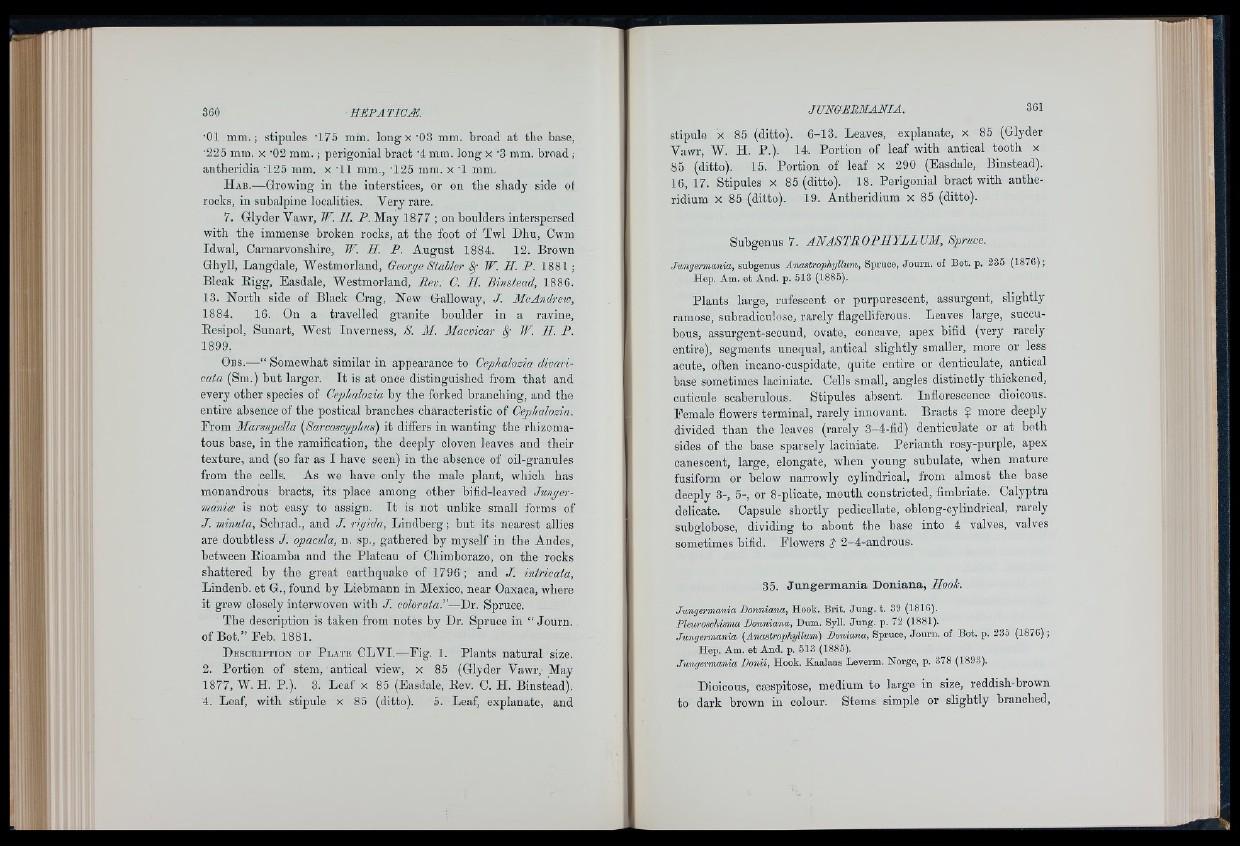
■01 mm.; stipules T75 mm. long x '03 mm. broad at tbe base,
•225 mrn. x '02 mm.; perigonial bract '4 mm. long x '3 mrn. broad;
antheridia T25 mm. x T1 mm., T25 mm. x T mm.
H ab.—Growing in the interstices, or on the shady side ot
rocks, in subalpine localities. Very rare.
7. Glyder Vawr, TF. II. P. May 1877 ; on boulders interspersed
with the immense broken rocks, at the foot of Twl Dhu, Cwm
Idwal, Carnarvonshire, TF. II. P. August 1884. 12. Brown
Gliyll, Langdale, Westmorland, Georye Stabler fl TF. II. P. 1881 ;
Bleak Eigg, Easdale, Westmorland, Eev. C. II. Binstead, 1886.
13. North side of Black Crag, New Galloway, ,1. McAndreiv,
1884. 16. On a travelled granite boulder in a ravine,
Eesipol, Snnart, West Inverness, S. M. Macvicar fl TF. II. P.
1899.
Obs.— “ Somewhat similar in appearance to Cephalozia divaricata
(Sm.) but larger. I t is at once distinguished from that and
every other species of Cejjhalozia by the forked branching, and the
entire absence of the postical branohes characteristic of Cephalozia.
From Marsupella (Sarcoscyphiis) it differs in wanting the rhizomatous
base, in the ramification, the deeply cloven leaves and their
texture, and (so far as I have seen) in the absence of oil-granules
from the cells. As we have only the male plant, which has
monandrous bracts, its place among other bifid-leaved Junyer-
manice is not easy to assign. I t is not unlike small forms of
J. minuta, Sobrad., and J. riyida, Lindberg; but its nearest allies
are doubtless J. opacida, n. sp., gathered by myself in the Andes,
between Eioamba and the Plateau of Chimborazo, on the rocks
shattered by the great earthquake of 1796; and J. intricata,
Lindenb. et G., found by Liebmann in Mexico, near Oaxaca, where
it grew closely interwoven with J. colorata.”—Dr. Spruce.
The description is taken from notes by Dr. Spruce in “ Journ.
of Bot.” Feb. 1881.
D escription o r P late CLVI.— Fig. 1. Plants natural size.
2. Portion of stem, antical view, x 85 (Glyder Vawiy May
1877, W. H. P.). 3. Leaf x 85 (Easdale, Eev. C. H. Binstead).
4. Loaf, with stipule x 85 (ditto). 5. Leaf, explánate, and
stipule x 85 (ditto). 6-13. Leaves, explánate, x 85 (Glyder
Vawr, W. H. P.). 14. Portion of leaf with antical tooth x
85 (ditto). 15. Portion of leaf x 290 (Easdale, Binstead).
16, 17. Stipules x 85 (ditto). 18. Perigonial bract with antheridium
x 85 (ditto). 19. Antheridium x 85 (ditto).
Subgenus 7. ANASTEOPHYLLUM, Spruce.
Jungermania, subgenus Anastrophyllum, Spruce, Journ. ot Bot. p. 285 (1876);
Hep. Am. e t And. p. 513 (1885).
Plants large, rufescent or purpuresoent, assurgent, slightly
ramose, subradiculose, rarely flagelliferous. Leaves large, suooubous,
assurgent-secund, ovate, concave, apex bifid (very rarely
entire), segments unequal, antioal slightly smaller, more or less
acute, often incano-cuspidate, quite entire or denticulate, antical
base sometimes laciniate. Cells small, angles distinctly thickened,
outioule soaberulous. Stipules absent. Inflorescence dioicous.
Female flowers terminal, rarely innovant. Bracts ? more deeply
divided than the leaves (rarely 3-4-fid) denticulate or at both
sides of the base sparsely laciniate. Perianth rosy-purple, apex
canescent, large, elongate, when young subulate, when mature
fusiform or below narrowly cylindrical, from almost the base
deeply 3-, 5-, or 8-plioate, mouth constricted, fimbriate. Calyptra
delicate. Capsule shortly pedicellate, oblong-cylindrical, rarely
subglobose, dividing to about the base into 4 valves, valves
sometimes bifid. Flowers $ 2-4-androus.
35. Ju n g e rm an ia Doniana, Hook.
Jungermania Donniana, Hook. Brit. Ju n g . t. 89 (1816).
Pleuroschisma Donniana, Dum. Syll. Ju n g . p. 72 (1881).
Jungermania (Anastrophyllum) Doniana, Spruce, Jo u rn . of Bot. p. 235 (1876);
Hep. Am. e t And. p. 513 (1885).
Jungermania Donii, Hook. Kaalaas Leverm. Norge, p. 378 (1893).
Dioicous, cæspitose, medium to large in size, reddish-brown
to dark brown in colour. Stems simple or slightly branched.